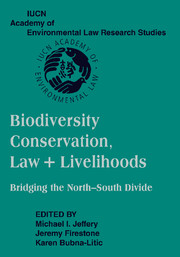 Biodiversity Conservation, Law and Livelihoods: Bridging the North-South Divide
Biodiversity Conservation, Law and Livelihoods: Bridging the North-South Divide Book contents
- Frontmatter
- Contents
- Acknowledgments
- Message from Kofi A. Annan, Secretary-General of the United Nations
- Macquarie Statement
- Contributors
- Introduction
- PART ONE THE CONTEXT
- PART TWO BIODIVERSITY: ITS CONSERVATION
- PART THREE CONSERVATION MEASURES
- PART FOUR USES OF COMPONENTS OF BIODIVERSITY
- PART FIVE PROCESSES AFFECTING BIODIVERSITY
- PART SIX BIOSECURITY ISSUES
- 25 Prevention and Control of Alien Invasive Species – China's Implementation of the CBD
- 26 Who Is to Blame? Liability and Redress Related to GMOs
- 27 The Reality and Effect of “Advance Informed Agreement” under the Cartagena Protocol
- PART SEVEN ACCESS AND BENEFIT-SHARING
- Index
25 - Prevention and Control of Alien Invasive Species – China's Implementation of the CBD
Published online by Cambridge University Press: 31 July 2009
- Frontmatter
- Contents
- Acknowledgments
- Message from Kofi A. Annan, Secretary-General of the United Nations
- Macquarie Statement
- Contributors
- Introduction
- PART ONE THE CONTEXT
- PART TWO BIODIVERSITY: ITS CONSERVATION
- PART THREE CONSERVATION MEASURES
- PART FOUR USES OF COMPONENTS OF BIODIVERSITY
- PART FIVE PROCESSES AFFECTING BIODIVERSITY
- PART SIX BIOSECURITY ISSUES
- 25 Prevention and Control of Alien Invasive Species – China's Implementation of the CBD
- 26 Who Is to Blame? Liability and Redress Related to GMOs
- 27 The Reality and Effect of “Advance Informed Agreement” under the Cartagena Protocol
- PART SEVEN ACCESS AND BENEFIT-SHARING
- Index
Summary
INTRODUCTION
With the expansion of global trade and international transport and tourism after China's integration into the world economy through the implementation of its open-door policy in the 1980s and the more recent accession to the World Trade Organization (WTO), China's biodiversity is becoming more and more threatened by the potential introduction of nonnative species. According to the very latest statistics from the Ministry of Agriculture, more than four hundred alien species have invaded China, at least twenty in the last ten years. Alien invasive species are found in all of the thirty-four provinces, autonomous regions, and municipalities under direct control of the central government. By May 2002, they had invaded almost all of the fifteen hundred nature reserves nationwide and all types of ecosystems, including forests, farmlands, inland waters, wetlands, grasslands, and urban residential areas. More than half of the world's worst alien invasive species published by the IUCN have invaded China.
The international community has become aware of the serious threat of alien invasive species to the ecosystem, biodiversity, human health, and socioeconomic well-being. Studies have found that the introduction of nonindigenous species is second only to direct habitat destruction in causing loss of biodiversity.
- Type
- Chapter
- Information
- Biodiversity Conservation, Law and Livelihoods: Bridging the North-South DivideIUCN Academy of Environmental Law Research Studies, pp. 465 - 484Publisher: Cambridge University PressPrint publication year: 2008
